

Forgery of coins has existed for almost as long as the concept of coinage its self and there are lots out there just waiting to fool the inexperienced collector. There are many techniques that can be used by the counterfeiter to aid his ill gotten games, but with a bit of training it should be possible to spot most. As detectorist I have to say we are a little safer than collectors because most of the forgeries we find will be contemporary and thus easily identified. But even if this fact is true we should arm ourselves with knowledge to combat this growing problem, so sit back and get ready for my gallery of The Good, The Bad and The Damn Right Pitiful!

These are copies made with the intention of selling to the general public and tourists . There is no deceit here, most will be clearly marked as a copy either on the copied works or on the packaging that comes with the product. Most honest copies I have seen are very crude, made in the wrong metal and you can tell a mile off that these coins are fake. Their designs are usually accurate to the real thing but the detail will look fuzzy and there will be a loss of definition over the original. Often the edges on these copies will display clues such as seams and file marks, evidence of the casting process that has been used to manufacture them. These are easy to spot because they were never supposed to deceive in the first place. I have a number of Roman coin copies and these are all stamped with WRL which is probably the manufacturer's initial. I also have a few hammered coin copies and these are clearly marked on the packaging that came with them. All these marked copies would be very difficult to confuse with the originals.

These have been forged with the intention of defrauding the general public at the time the original coin in question was in circulation. As a metal detectorist these forgeries are the ones that mostly concern us because they are more likely to be found than any of the others. Almost all of the counterfeits that fall into the contemporary category are produced by casting. In the worst examples the detail on these coins are completely wrong with the legends miss spelled or parts missing, date chronology incorrect, poor design detail and in some cases obverse and reverse miss matching. Coins produced by casting will of course display traits of their manufacture, fuzziness, porosity, bubbled surfaces and joined or filed edges are all a dead give away. Also because metal shrinks when it cools cast forgeries will always appear slightly smaller than the originals. Weight is one of the hardest things for the forger to get right particularly with gold. Gold coins all have a very specific weight, so if you dig a Guinea or Sovereign and find it to be particularly light then don't be surprised to find out later that it is a fake.
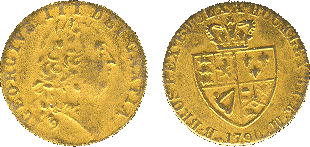 |
Take a look at this George III guinea. At fist glance it appears to be very good, but take a closer look. You can see that the coin has an overall very fuzzy almost grainy look to it, direct evidence of casting. The inscription on the obverse (head side) of the coin reads GEORGIVS III DEI GRATIA which is correct but HOKLEY B I R M B BROS REX FD CLXX on the reverse (tail side) is completely wrong and should be M B F ET H REX F D B ET L D S R I A which gives the correct titles for George III. This mistake to me is the most obvious give away and shows this coin is a forgery, as is the weight which is far too light for gold. Another give away is the colour, this coin looks far too matted and yellow to be gold and the lustre is just awful. It may have fooled someone back in the day but it certainly doesnít fool me. |
||||||
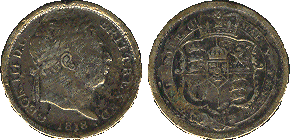 |
Here is an example for a George III shilling. This coin is made from brass and may originally have had a silver wash over the surface which has long since been worn away. All the details are correct but again there is an overall fuzzy mottled look to the surface. There is also evidence of bubbles which would have been trapped air when the coin was made, yes! Again we are talking about casting as the preferred method used by the forger. |
||||||
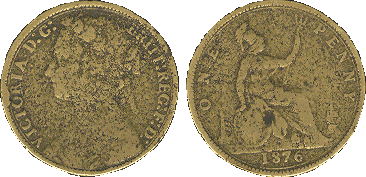 |
Now take a look at this Victorian penny. The designs are all correct but the first thing that immediately sticks out is the fact it's made of brass and not bronze. The colour is completely wrong and I must admit I think that someone was having a joke when they made it. The size is slightly smaller than a real Victorian penny, but as I have said before the most important thing I should point out is the mottled fuzzy effect that you can see all over the surface. Again this is evidence of the casting process where air entrapment has caused a disturbance on the surface of the forgery before it has had the chance to cool and solidify in the manufacturing process. |
||||||
Yes contemporary forgeries are still a problem even today! Take a look at these three pound coins that I have pulled out of circulation. The one on the left is made from lead covered with a brass wash. Convincing when it was new but now completely obvious because the brass wash has started to wear off. Take a look at what I think is our forgerís second attempt at creating a counterfeit pound coin (Centre). This oneís made from solid brass, the metal composition isnít right it should be made from nickel-brass and hence the colour is completely wrong. The colour should look more like the third pound coin on the right. Also the date on the obverse (head side) does not match the design on the reverse (tail side) for that particular year. The reverse design is the Scottish thistle and yet the crude edge inscription (not shown) reads DECUS ET TUTAMEN the English title instead of NEMO ME IMPUNE LACESSIT the Scottish one. Not only that but the whole inscription is up the wrong way, clearly our forger has very little knowledge of English coinage but his second attempt is better than his first. Finally we come to our forgerís most recent attempt to copy English currency. The coin on the right is quite worrying even though to me it still looks like an obvious fake. The colour of the coin is practically identical to the genuine article and the obverse (head side) does match the reverse (tail side) design for that particular year. This coin is the exact same size and almost the same weight as an original, but the fuzzy surface effect tells me that casting has been used somewhere in the manufacturing process. The edge inscription again reads the English DECUS ET TUTAMEM and is wrong for the reverse design which is Welsh. The inscription should read PLEIDIOL WYF I'M GWLAD and if this isn't bad enough it is still very crude and up the wrong way. The letters on the inscriptions and general fuzzy effect give this coin away. The forger has managed to get the colour, size, weight, obverse and reverse of this coin right, but it appears that he has not yet taken up design and die studies. He has made obvious advances over what I think is his second attempt at forging, let us hope that he is caught by the police before he learns any more. |
|||||||
|
|||||||

Professional counterfeits have been especially produced with the intended purpose of fooling experienced coin collectors; these also include original coins that have been altered in some way to make them appear rarer than what they actually are. These forgeries are a real problem it being almost impossible to tell the difference between the copy and the real thing. Detail is usually accurate and the design as sharp as the original. Some have been produced using the actual dies that were used to produce the originals, so called re-strikings. In this case it is best to look at die axis to see if the obverse (head side) and reverse (tail side) are the same as the genuine article. Also look at the quality of the striking, is it central? Is all the detail there? If everything looks okay then it is probably genuine. If you are still unsure then weigh the coin and compare that to the weight of an authenticated one. Weight is one of the hardest things for the forger to get right. Checking the metal of the coin to see if it is made from the right alloy can in most cases give 99.9% certainty that the item in question is either good or a dud. Some will be obvious and some will not. The most obvious examples will be those that have been plated, or those made from completely the wrong metal. The tricky ones will appear to be made from the correct metal however their alloys and composition will be slightly different from the originals. In this case a specialist piece of equipment such as a Scanning Electron Microscope (SEM) can be used to find the differences. But having something like this done would probably be expensive and hence it is not recommended for the majority of suspected forgeries. Only those in the category of extremely rare would be worth subjecting to this test as their value is usually high enough to warrant closer inspection. Earlier I mentioned altered coins as a potential for professional counterfeits but these are usually quite easy to spot if you know what to look for. A typical example of this is date altering where by the date of a common coin is altered to that of a rarer one. Using a magnifying glass it should be possible to see scratch marks around the suspected number or letter character. If the forger has been particularly skilful in his or her work than check against the same on an original to see if there is any miss shaping in the way the suspect character has been formed. Like the type face or font on a computer the letter and number characters on a coin should all fit and flow nicely (except hammered). If a letter looks deformed and doesnít seem to fit with the others then it has probably been altered. (Donít confuse altered coins with ones that have been over struck with a different date. In a coin catalogue this might be shown as 1868/7, 8/7, or 1868 over 7 for example. Such specimens of this type are usually well sought after.)
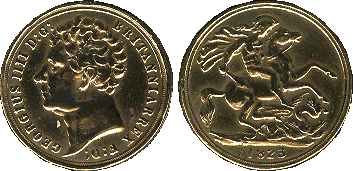 |
Here is a very good copy of a George IV gold 2 pounds. There is no evidence of casting and all the detail is crisp and clear. When polished as in the picture this brass copy looks extremely convincing, all the legends are correct as is the date 1823. There are thank goodness a few give always that allow us to categorise this coin as a fake. The first and most immediately obvious is the weight which is too light. Secondly the head of St George on the reverse is slightly out of shape compared to an original. Third and finally the portrait of George IV isnít quite right, the nose is too large, the jaw line too heavily pronounced and the neck badly sunken in. Other than those points for shear effort you could almost give the forger a pat on the back, but of cause we're not going to! |
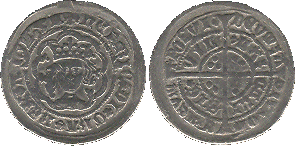 |
Take a look at this copy of what I think is a Henry VI half groat. All the detail looks correct and the design very clear. There is no evidence of bubbles, fuzziness or mottling which is the type of evidence suggestive of casting. The only two things that give this coin away are the weight and the size. If you look closely at the picture you will see that the flan (blank) of the coin looks too large to fit the design. It almost looks deliberate and I believe the reason for doing it is the forgers attempt at trying to get the weight of the coin right. All it has done is highlighted the size of the original coin from which the design has been copied. Had this coin been the right size and weight then it would perhaps have been quite a worrying copy. |

Hear are a few pictures which might help illustrate what we are looking for when tying to spot a fake.
So called fuzziness! Just look at the poor detail and definition especially on the lettering, typical results from casting. CLICK HERE and take a look at the full coin. |
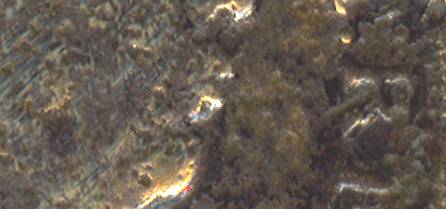 |
Surface mottling cause by hundreds of tiny air bubbles during the casting process which leaves the surface of this coin looking very rough and uneven. CLICK HERE and take a closer look. |
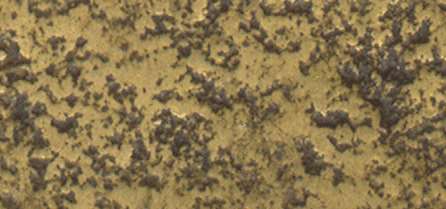 |
Bubbles pockmark the surface on this coin like craters on the Moon, another sure sign of casting. CLICK HERE for a better view. |
 |
Here are some other forgeries I have found |
|
1817 Half Crown CLICK HERE |
A very poor quality bronze cast copy. |
1818 Half Crown CLICK HERE |
This brass plated copy would have been quite convincing in its day. No signs of casting anywhere and very accurate design detail. |
1831 Half Crown CLICK HERE |
One of the worst cast copies I have ever seen. Also has heavy damage. |
Napoleon III coin CLICK HERE |
This is with out doubt the worst cast copy I have ever come across. |

Nearly all these are museum reproductions for displays however there are some out there that could quite easily be passed off as genuine. The thing you have to do with ancient artefacts is check their construction against the original, especially jewellery, brooches and buckles. Also check for corrosion on bronze and silver. Corrosion can be faked but when you have got experience you can in most cases easily tell the difference between a genuine and fake patina. Bronze Age axe heads and other tools can be a little trickier as the contemporaries were produced by casting, a known favourite method used by forgers. In this case enlist the help of a specialist; I would go to my local museum for help and then to the British Museum if required. Metal composition is everything when it comes to spotting the really difficult fakes. Bronze and silver obtained today will be different in composition from what it was thousands of years ago. The trace elements such as carbon which comes from CO2 (carbon dioxide) is far higher today than it was in ancient times. Museums can test for this and other trace elements to see if the object in question is made from modern day alloys. In the case of gold the latter applies but weight is very important, always try to check the weight of an object if made from gold. All I can say is if the object is very light then I would start to get worried.

Good forgeries at the moment are rare and fortunately not wide spread, but with new discoveries and copying techniques forgery is beginning to become more of a problem. Letís hope the law catches up with the forgers before they taint our hobby. In the mean time arm yourselves with knowledge and donít let them get away with it!